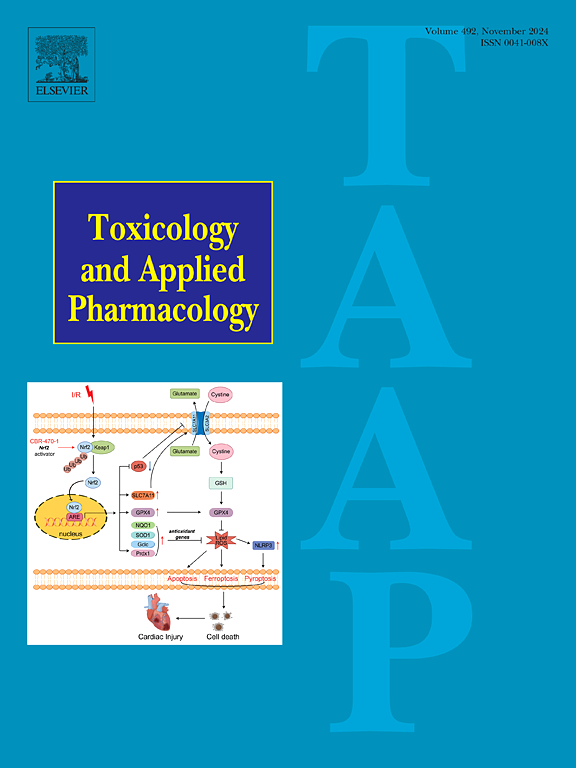Shikonin modulates activated fibroblast apoptosis in silicosis fibrosis via the PI3K/Akt signaling pathway: A network pharmacology approach
IF 3.3
3区 医学
Q2 PHARMACOLOGY & PHARMACY
引用次数: 0
Abstract
Background
Silicosis is a lung disease caused by the inhalation of free crystalline silica and is characterized mainly by lung inflammation and progressive pulmonary fibrosis. Shikonin, a biologically active compound isolated from the traditional Chinese medicine Comfrey, has been shown to have significant antifibrotic effects. However, the molecular mechanisms underlying the antifibrotic effects of SHK in silicosis remain unclear.
Methods
This study used a combination of network pharmacology, molecular docking, molecular dynamics simulation, and in vitro experimental validation to investigate the potential targets of SHK in silicosis.
Results
Network pharmacology analysis identified 208 cross genes associated with disease drugs. Gene Ontology (GO) and Kyoto Encyclopedia of Genes and Genomes (KEGG) analysis show that these intersecting genes are significantly associated with the PI3K/Akt signaling pathway. Protein protein interaction (PPI) network analysis further revealed 10 core crossover genes, namely ALB, Akt1, STAT3, CASP3, EGFR, MMP9, Bcl-2, ESR1, HSP90AA1, and NF-κB1. Among them, Akt1 and Bcl-2 have the strongest binding ability to SHK. The in vitro experimental results showed that SHK can significantly inhibit the activation of fibroblasts and promote apoptosis of activated fibroblasts through the PI3K/Akt signaling pathway.
Conclusion
SHK alleviates silica induced silicosis fibrosis by inhibiting the transformation of fibroblasts into myofibroblasts through the PI3K/Akt signaling pathway.
紫草素通过PI3K/Akt信号通路调节矽肺纤维化中活化的成纤维细胞凋亡:网络药理学方法
背景:矽肺病是一种由吸入游离结晶二氧化硅引起的肺部疾病,主要表现为肺部炎症和进行性肺纤维化。紫草素是一种从紫草中分离出来的生物活性化合物,具有显著的抗纤维化作用。然而,SHK在矽肺中抗纤维化作用的分子机制尚不清楚。方法:本研究采用网络药理学、分子对接、分子动力学模拟、体外实验验证相结合的方法,探讨SHK在矽肺中的潜在靶点。结果:网络药理学分析鉴定出208个与疾病药物相关的交叉基因。基因本体(GO)和京都基因与基因组百科全书(KEGG)分析表明,这些交叉基因与PI3K/Akt信号通路显著相关。蛋白蛋白相互作用(PPI)网络分析进一步发现了10个核心交叉基因,分别是ALB、Akt1、STAT3、CASP3、EGFR、MMP9、Bcl-2、ESR1、HSP90AA1和NF-κB1。其中,Akt1和Bcl-2对SHK的结合能力最强。体外实验结果表明,SHK可通过PI3K/Akt信号通路显著抑制成纤维细胞的活化,促进活化成纤维细胞的凋亡。结论:SHK通过PI3K/Akt信号通路抑制成纤维细胞向肌成纤维细胞的转化,从而减轻二氧化硅诱导的矽肺纤维化。
本文章由计算机程序翻译,如有差异,请以英文原文为准。
求助全文
约1分钟内获得全文
求助全文
来源期刊
CiteScore
6.80
自引率
2.60%
发文量
309
审稿时长
32 days
期刊介绍:
Toxicology and Applied Pharmacology publishes original scientific research of relevance to animals or humans pertaining to the action of chemicals, drugs, or chemically-defined natural products.
Regular articles address mechanistic approaches to physiological, pharmacologic, biochemical, cellular, or molecular understanding of toxicologic/pathologic lesions and to methods used to describe these responses. Safety Science articles address outstanding state-of-the-art preclinical and human translational characterization of drug and chemical safety employing cutting-edge science. Highly significant Regulatory Safety Science articles will also be considered in this category. Papers concerned with alternatives to the use of experimental animals are encouraged.
Short articles report on high impact studies of broad interest to readers of TAAP that would benefit from rapid publication. These articles should contain no more than a combined total of four figures and tables. Authors should include in their cover letter the justification for consideration of their manuscript as a short article.

 求助内容:
求助内容: 应助结果提醒方式:
应助结果提醒方式:


